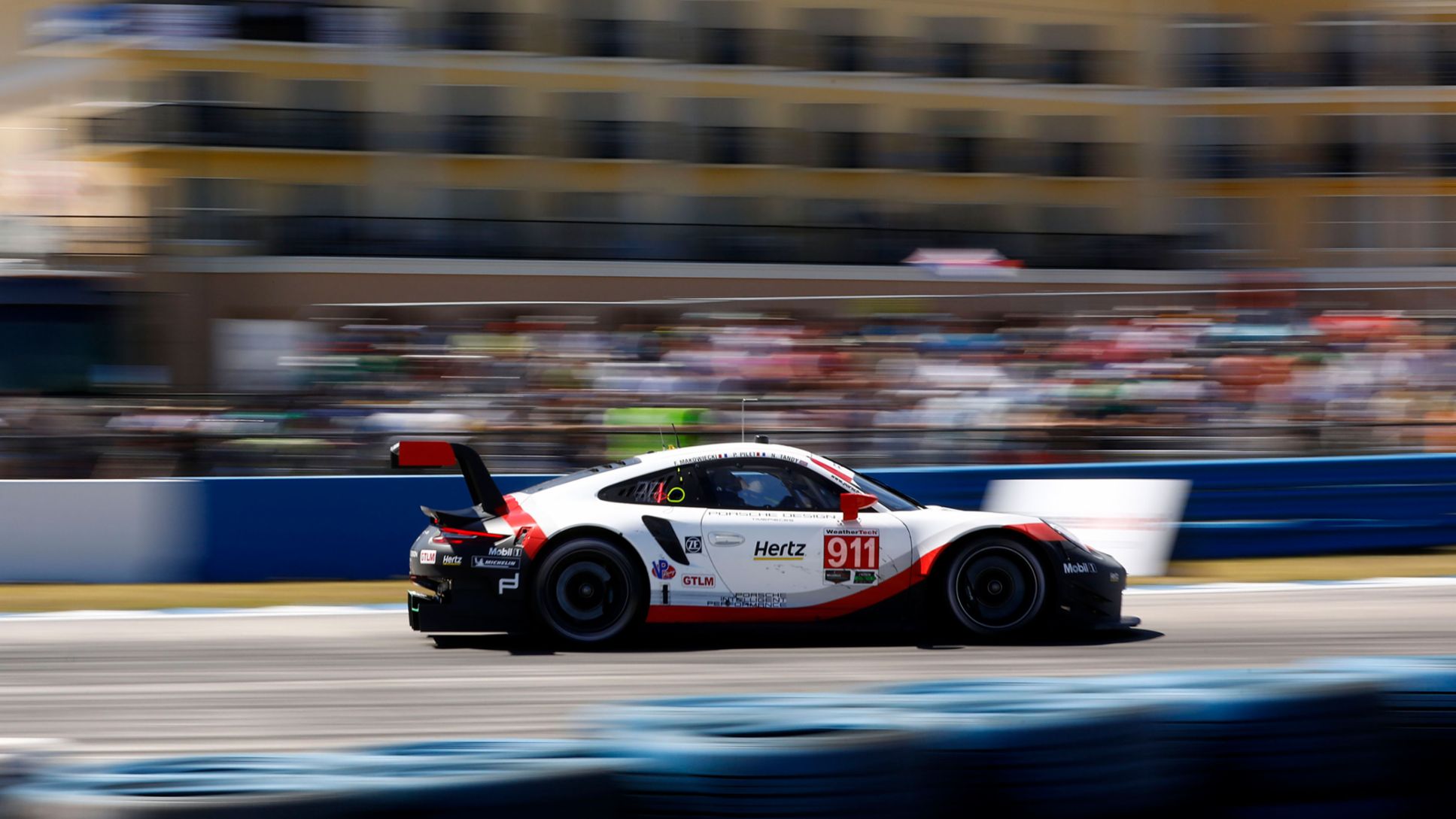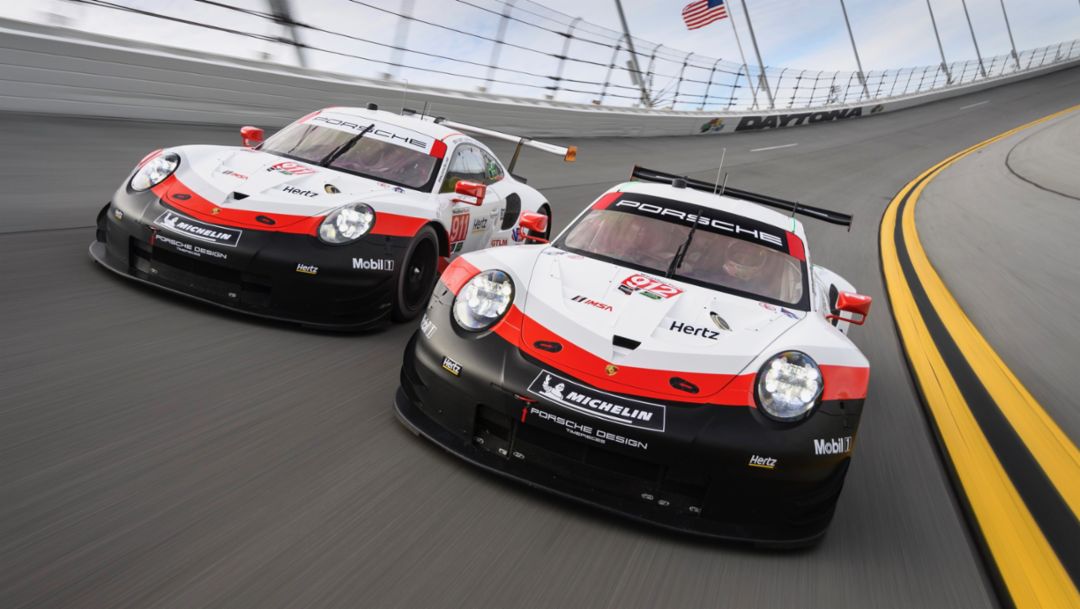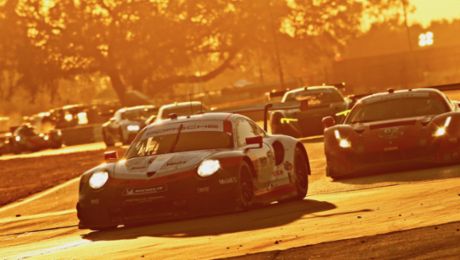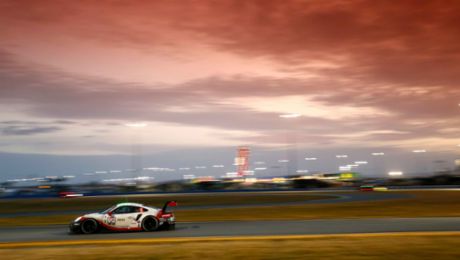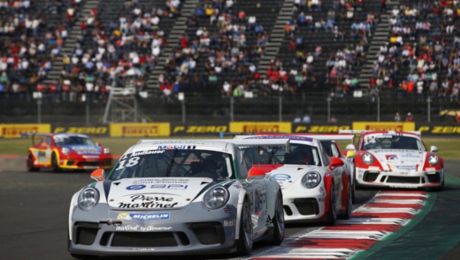On the 3.167-kilometre street circuit, the Porsche GT Team fields two Porsche 911 RSR racers against three other automobile manufacturers in the strongly represented GTLM class. In addition to these fascinating sports cars, fans can look forward to a real highlight of the season at Long Beach, where another very popular US series, IndyCar, also contests a championship round on the same weekend. After winning the Sebring 12-hour race, Porsche has moved into second place in the manufacturers’, drivers’ and team classifications of the IMSA SportsCar Championship. Porsche also ranks second in the prestigious North American Endurance Cup. The long-distance races at Daytona, Sebring, Watkins Glen and Petit Le Mans count towards the toughest category in terms of performance and reliability in GT racing worldwide.
The race
During construction of the street circuit around the port area of Long Beach, more than five kilometres of fencing was erected and 1,400 concrete blocks were laid. The race with the picture-postcard backdrop of sun, sea and palms is regarded as the American equivalent to the Monaco Grand Prix. In fact, the street course hosted the Formula 1 United States Grand Prix West from 1976 to 1983. And like in the Principality on the Cote d’Azur, there is no lack of stars and starlets. No wonder – the Hollywood dream factory is just around the corner.
The Porsche drivers
In the cockpit of the #911 Porsche 911 RSR, Patrick Pilet (France) and Nick Tandy (Great Britain) contest the GTLM class. These two won the Long Beach race in 2016 and recently clinched the first win of this season in Sebring with the 911 RSR. Laurens Vanthoor (Belgium) and Earl Bamber (New Zealand) share driving duties in the second 911 RSR (#912) fielded by the Porsche GT Team. The GTD class, in which Porsche customer teams campaign the 911 GT3 R, is not contested at Long Beach.
Competitors must be able to drive their race cars at the limit over long race distances. And they can’t make any mistakes. When instructions are sent through from the pits, they must be able to adjust their driving style according to the situation, for instance to save fuel or conserve tyres. But they must never get too slow. And should the race situation require, they must also attack with complete dedication. Their task is further complicated by the fact that they not only have to contest their own class but also take into account that there are other cars on the racetrack with very different power outputs. This poses a huge risk. While they fight against almost identical competitors in the GTLM class, they also have to overtake and watch out for much slower GTD cars, while at the same time being overtaken by more powerful prototypes. In such situations, many mistakes can happen. The big challenge in the IMSA Championship is to get past the GTD cars without getting held up, and to allow the prototypes to overtake at the right place without hampering their charge too much. To correctly gauge these situations within a matter of seconds requires great care and experience.
Porsche carefully chooses its drivers not least because of such demands. Thanks to the structure of the worldwide one-make cup series and special selection processes, talented young hopefuls are recognised early on and supported. The Porsche Junior Programme is a unique success story within the motor racing world and has produced many former and current works drivers. The Porsche Young Professionals are on the brink of becoming works drivers and are supported and promoted by Porsche in their GT-racing campaigns with customer teams around the world.
The 911 RSR
In addition to the optimised setup of the 911 RSR, the reliability has been further improved for its second racing season. Depending on the size of the restrictor, the motor, which is positioned in front of the rear axle, puts out around 375 kW (510 hp). The large rear diffuser combined with a top-mounted rear wing provides strong downforce and aerodynamic efficiency.
Unlike a single-seater or Le Mans Prototype, a GT racer must be based on a production car, as stipulated in the regulations. The rules in the GTE/GTLM category are very restrictive and afford engineers very little leeway for development. With the latest 911 RSR, the designers at Weissach have systematically capitalised on every possibility within the regulations. The engine has been repositioned in front of the rear axle to make room for a larger rear diffuser. Diffusers powerfully press the rear to the track surface at high speeds without drastically increasing the drag. For the most part, the 911 RSR is characterised by very efficient aerodynamics, or in other words, high downforce with low air resistance. Thanks to the changed centre of gravity, the load is distributed over the tyres more evenly, thus achieving a consistently higher grip level for the tyres than the previous rear-engine concept allowed.
The tyres
Tyres are a critical factor in the performance of a race car. How well they work depends on the temperature, the condition of the track surface and the racetrack itself. Finding the right tyres for all conditions in setting up the vehicle is one of the keys to success. The car and tyre combination has to be as fast as possible without the rubber deteriorating too much. In a U.S. race, the tyres have to maintain their integrity for at least an hour – the normal length of time between pit stops. In the WEC, they even have to survive a double stint without losing too much grip.
The schedule
The race takes off on Saturday, 14 April, at 13.05 hrs local time (22.05 hrs CEST) and can be viewed live outside the USA on www.imsa.com.
Pre-race quotes
Dr Frank-Steffen Walliser, President Motorsport and GT Cars: “After our phenomenal win at the Sebring 12-hour classic, we’re now going to tackle the shortest race of the season at Long Beach. The contrast couldn’t be greater. California is the most important Porsche market in the United States. That makes this race a very special challenge for us. Many of our customers and fans travel from far and wide to watch the 911 RSR on a fascinating city circuit. For us, this intense interest is an obligation to do everything we can to fight for victory and give the spectators an impression of this Porsche’s potential. Aside from that, Long Beach, which is regarded as the Monte Carlo of America for good reason, is an absolute highlight of the season.”
Pascal Zurlinden, Director GT Factory Motorsports: “The entire squad comes under intense pressure at Long Beach. The short race is a real thriller. Drivers can’t afford to make the slightest mistake on this narrow city circuit, otherwise they end up hitting the wall. And every second we lose in the pits hurts twice as much. Refuelling, new tyres, driver changes – nothing must go wrong at the sole pit stop, otherwise you’ve lost the race. Finding the perfect setup for our 911 RSR in the short practice session is another huge challenge.”
Patrick Pilet (911 RSR #911): “The Long Beach city circuit is one of my favourite racetracks in the States. We won two years ago there, and we now want to do it again. After our Sebring victory, the whole team is hugely motivated. Fans know very well why they come to Long Beach: To constantly push the limits on this demanding course with total commitment is a huge challenge for the drivers and guarantees some action-packed racing.”
Nick Tandy (911 RSR #911): “Long Beach is a very special place to go racing. It’s a fantastic city circuit and great fun. The comparison to Monaco really fits. The racetrack is tricky and the more rubber that’s left on the track, the faster we get from one practice to the next. Finding the perfect setup for our 911 RSR during the short practice session puts the entire team under pressure right from the start.”
Laurens Vanthoor (911 RSR #912): “I really like street circuits. They pose a special challenge because you have to stay totally focussed the whole time and you can’t afford to make one mistake. The fact that we’re driving here on the same weekend as the IndyCar Series makes the race one of the season highlights for us and the fans.”
Earl Bamber (911 RSR #912): “Long Beach is unique. The city circuit is one of the most beautiful in the world, but it’s also one of the most difficult. There are virtually no run-off areas. Every mistake has immediate consequences. If you take a corner too fast you’ll hit the wall. I love street circuits. They’re something very special and a wonderful change for us drivers. And aside from that, California with its sun and beaches is simply fun.”
#IMSA - Racing between walls, tyres and fences: The #BUBBAGP on Saturday at Long Beach is one of the biggest challenges for the #911RSR, the #WeatherTechChampionship has to offer. The #Sebring12 winning #PorscheGTTeam is ready for the "Monte Carlo of America". @Porsche pic.twitter.com/4Gsmosodkr
— Porsche Motorsport (@PorscheRaces) 11. April 2018
The Balance of Performance
In GT racing, vehicles with very different concepts serve as the basis. Thus, cars with front, mid or rear engines represent the foundation – cars with different frontal areas, with turbo or normally aspirated engines, with large or small displacements, with heavier or lighter weights. The Balance of Performance was introduced to in theory achieve a level playing field for all of these vehicles. All cars may only compete within a predetermined performance window. Influences such as team performance, strategy and driver ability are not factored into the BoP. The most common ways of adjusting the performance level is through adding or removing weights as well as increasing or reducing the engine performance by means of a restrictor or boost. In keeping with the rule-makers’ intention, the key to success on the racetrack is not about the individual potential of a vehicle, instead it’s about the performance of the drivers, the race strategy, a perfect setup or the skill of the team with their pit stops. The BoP in the FIA WEC and the IMSA follows the same fundamental logic. Nevertheless, there are different BoP ratings and the adjustments are made independently. In contrast to Formula 1 or the LMP1 category, it is virtually impossible to eke out an advantage of several seconds per lap over another competitor. On the performance side, the BoP simply makes it impossible to build a significant gap to the competition in any way whatsoever.
The competition
No other racing series in the world is as hotly contested as the GTLM classes of the IMSA SportsCar Championship and FIA WEC. In addition to Porsche, four other automobile manufacturers tackle this famously cutthroat category: BMW, Chevrolet, Ferrari and Ford in the IMSA series as well as Aston Martin, BMW, Ferrari and Ford in the WEC. All of these manufacturers invest a great deal of technical effort, they have big budgets, and they only entrust their highly sophisticated race cars to professional teams and drivers. For this reason, the level of competition is inherently extremely high. At Sebring, the winning 911 RSR crossed the finish line only several seconds ahead of the best BMW – after twelve hours and 328 laps on the very demanding racetrack. To finish such a race as the winner, all factors must come together perfectly. The smallest mistake generally signals defeat.
The setup
Thanks to the setup, which is generally done by drivers and their teams during testing or at the latest during practice, the race car is adjusted as optimally as possible to suit the individual racetrack. Particularly during a long distance race, external conditions can change and affect track conditions. Hence, the setup choice must be made so that the race car performs well, despite the changing conditions. For this reason, a good setup is always a compromise between the many relevant parameters of each individual racetrack.
Strategies
When a situation crops up suddenly during the race, it’s time for the strategists to spring into action. In such a case, every team has specialists within its ranks who have to make split-second decisions, which often have a crucial and far-reaching impact on the remainder of the race. When a race runs its normal course, it is their job to observe what the competition is doing, to respond appropriately to changing conditions such a caution phases, accidents and weather changes, and to quickly and precisely keep the team abreast of any new situations. With the help of simulation programmes, strategists are able to predict and analyse within seconds how the race will run and, from this, make the right call for the driver and team.
The pit stops
There is no other racing situation where the team of mechanics are observed as closely as during the pit stop. Every mistake is captured on TV and mercilessly exposed by experts to viewers around the world. A pit stop is a well-rehearsed choreography. All procedures must flow perfectly, with all parties able to rely on each other implicitly. Every move must be flawlessly executed. A pit stop must comply to strict regulations and is monitored by officials. A mechanic standing too far from the pit wall or a wheelspin when starting (in the WEC) can lead to a time-consuming drive-through penalty. Races can be won in the pits – or lost.
The safety car phases
One of the peculiarities of sports car racing in the USA is that they are interrupted by safety car phases more often than anywhere else in the world. The idea behind these phases is to bunch the field together repeatedly with the aim of delaying the outcome of the race until shortly before the end and thus make the races more interesting for fans. In this final phase, where the cars are usually very close together, drivers need to be ready. In the last laps everything has to come together: the car has to work perfectly, the tyres mustn’t be too worn, the air pressure must be correct, and the setup must correspond exactly to the conditions. To anticipate and predict such critical racing situations is part of the strategist’s job.
This is the IMSA SportsCar Championship
The IMSA SportsCar Championship, a sports car race series contested in the USA and Canada, was run in 2014 for the first time. The series was formed from the merger of the American Le Mans Series and the Grand-Am Series. Sports prototypes and sports cars start in three different classes: GTLM (GT Le Mans), GTD (GT Daytona) and P (Prototype). The Porsche 911 RSR runs in the GTLM class, with the Porsche 911 GT3 R contesting the GTD class. Only the GTLM and P classes will be contested at Long Beach.
The differences between IMSA and WEC
There are various basic strategies that ensure success in the WEC and the IMSA SportsCar Championship. In the WEC, the closing up of the field by way of safety car phases is not as common as it is in the USA, hence the average performance over the entire race distance is of utmost importance. In the USA, on the other hand, the most important factor is not to make mistakes in order to be in a position in the final laps to turn a top performance into a good result.
